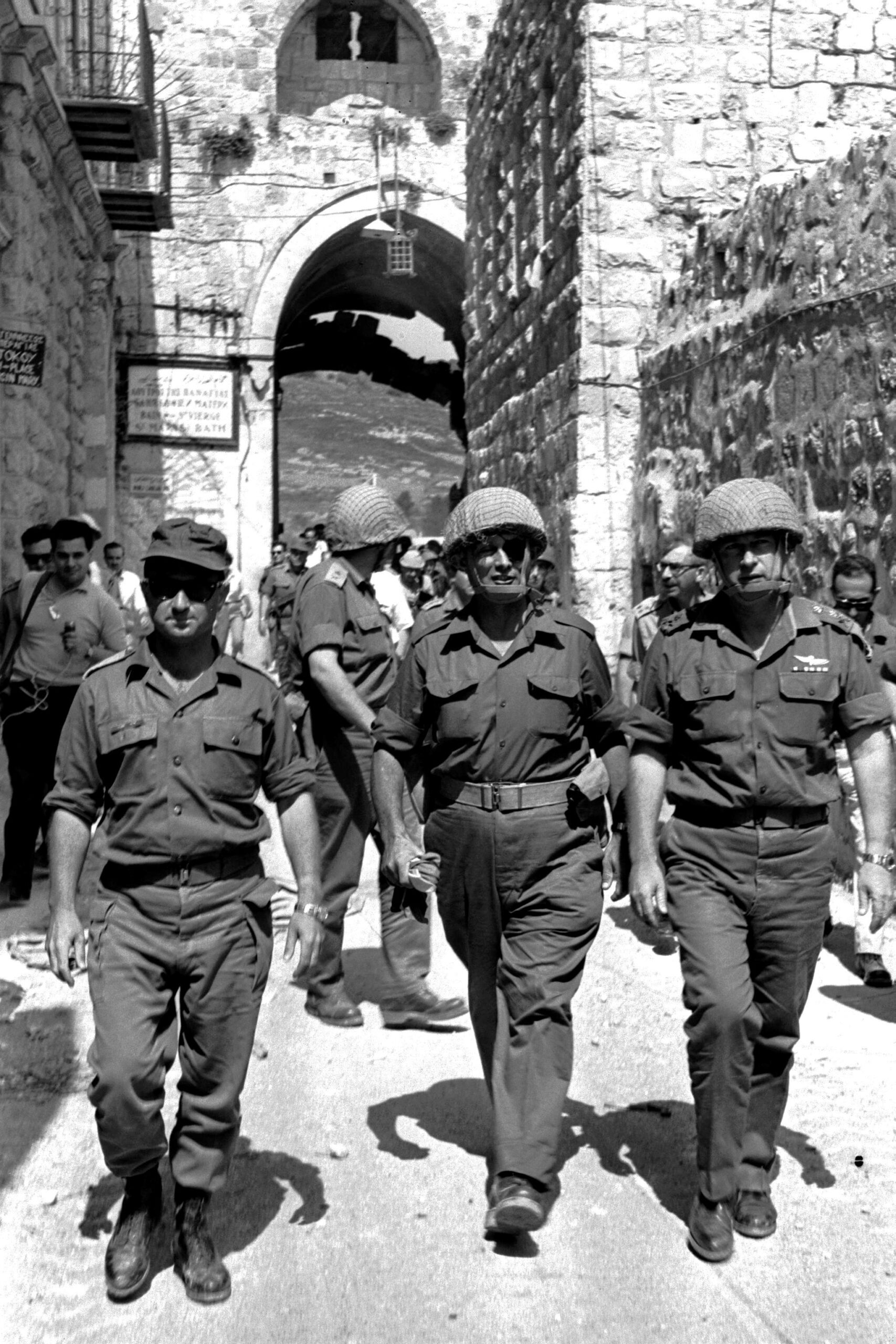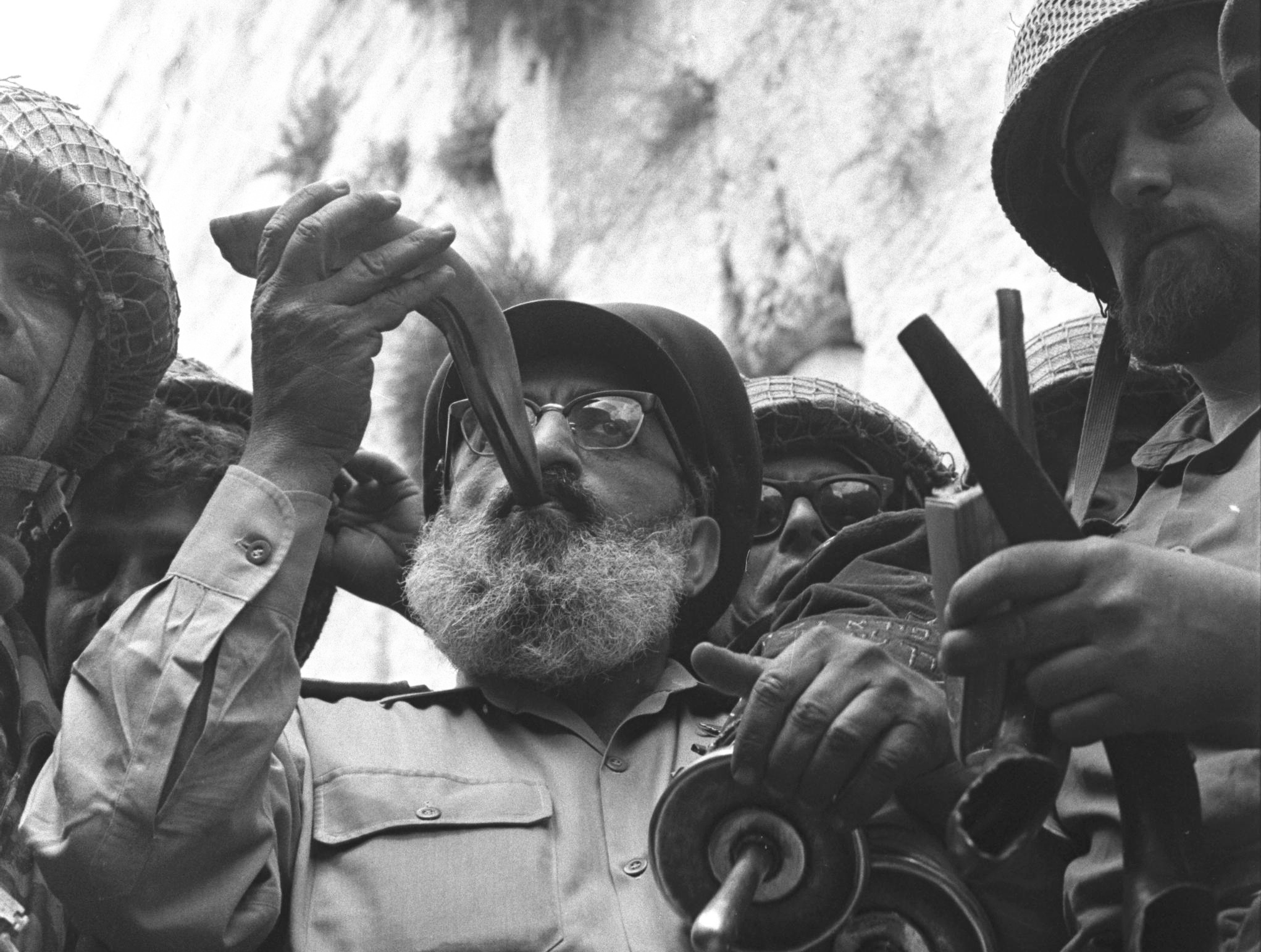Jewish prayer banned at Temple Site
Jews are allowed to visit the Temple Site but not to pray there. Nor may they visit in too large numbers. Behind this situation lie political decisions made during the Six Day War in 1967 in an attempt to appease the Muslim world and world opinion


Defense Minister Moshe Dayan flanked by Chief of Staff Yitzhak Rabin and Uzi Narkiss in the Old City of Jerusalem shortly after the city’s liberation in 1967. Photo: IDF
IDF Chief Rabbi Shlomo Goren blows the shofar at the Western Wall in June 1967. Photo: IDF
Moshe Dayan was Israeli Defense Minister during the Six Day War in June 1967 when the Western Wall and the Temple Mount in East Jerusalem were re-taken by the Israeli army. When paratrooper commander Mordechai Gur called out on his radio “The Temple Mount is in our hands!” and IDF Chief Rabbi Shlomo Goren blew the shofar at the Western Wall, it was the first time since Jerusalem’s destruction some 1900 years earlier that the city was not occupied by foreign states and world powers, but instead was in the hands of the Jewish people.
The site where Solomon’s Temple and the Second Temple had stood – as a thousand-year-old center for the spiritual life of the Jewish people – had remained ever-present during the 2000 years of the Diaspora in the daily prayers and Torah-readings of every believing Jew.
Despite this, the Israeli state conceded to strong restrictions on Jews visiting the Temple Mount.
Flag taken down
Moshe Dayan ordered Mordechai Gur to immediately remove the Israeli flag hoisted by paratroopers on the Temple Mount, saying: “Do you want to set the whole Middle East on fire?” Dayan also removed the company of paratroopers from the northern end of the mount and notified Uzi Narkiss, head of Central Command, that the site would be handed over to the Waqf, a Jordanian organization that since 1948 had managed the Muslim buildings on the Temple Mount, writes the Jerusalem Center for Public Affairs, an independent research institute in Israel for national security and applied diplomacy.
Moshe Dayan then forbade Jews to pray at the Temple Mount, a decision which was criticized early on and remains controversial to this day. Half of Israel’s Jews support the idea that Jews should be allowed to pray on the Temple Mount in Jerusalem, according to a survey conducted by the Times of Israel last May. 40 percent said they were against it and the rest were unsure.
May not pray
Dayan’s decision was an attempt to contain the Arab-Israeli conflict and neutralize Palestinian nationalism. The State of Israel has since maintained the ban on Jews praying at the Temple Mount. The security police, the police and the Supreme Court have all been behind the decision, as well as Israel’s chief rabbi.
Dayan thought that for Muslims the mosque was a place of prayer, while for Jews it was nothing more than a “historical site for commemorating the past…”. The Israeli Defense Minister believed that Islam must be allowed to express its religious sovereignty—as opposed to national sovereignty—over the site, that the Arab-Israeli conflict must be kept at the territorial-national level, and that the potential for a conflict between the Jewish and Muslim religions must be removed. By granting Jews the right to visit the Mount, Dayan sought to appease Jewish demands for worship and sovereignty there, writes the Jerusalem Center for Public Affairs.
Limited times
Despite Dayan’s original decision, the police haven’t allowed free entry for Jews wishing to visit the Temple Mount for many years. They limit the numbers, especially of religious Jews, who can enter. Only a couple of dozen religious Jews are allowed there at any one time, and they’re shadowed by Waqf guards and police who keep an eye on them, checking their belongings making sure they haven’t ‘smuggled’ in a prayer shawl or prayer book, carefully noting that their lips don’t move in prayer.
The hours during which Jews have access to the Mount are also restricted and during riots the site is completely closed to them.
When Jordan occupied Jerusalem, the Jewish Quarter was destroyed and all but one of the 35 synagogues in the Old City were demolished. At the Jewish burial ground on the Mount of Olives, thousands of tombstones were smashed.
Israel has passed a Law on the Protection of Holy Places. This stipulates that such places will be protected from desecration and any other violation, and from anything likely to violate the freedom of access for members of the different religions to the places sacred to them, or their feelings with regard to those places.



